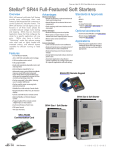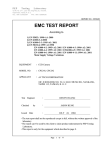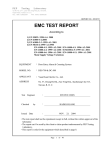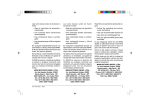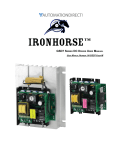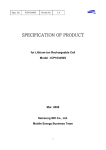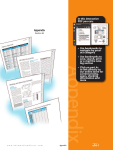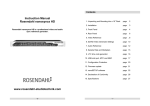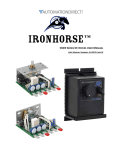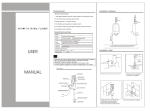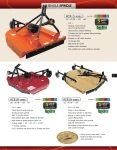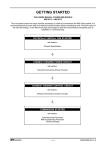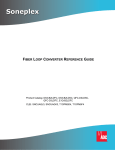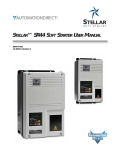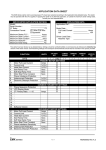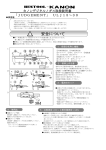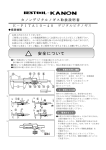Download Quick-Start Guide: Installation and Operation of
Transcript
Stellar SR44 Soft Starter Basic Quick-start Guide SR44 OPTIMIZING SOFT STARTERS QUICK-START GUIDE: INSTALLATION AND OPERATION OF THE SR44 SOFT STARTER Guide To Contents 1 – Mechanical Outlines Referring to the appropriate size of SR44, mount the SR44 ensuring that correct clearances are maintained for adequate ventilation and operation of the SR44. 2 – Wiring Diagrams Referring to the appropriate Wiring Diagram, install the SR44 electrical connections ensuring that the correct control supply voltage is used and is within the specified operating limits as described on the product specification. WARNING: Always replace the cover panel on the unit after gaining access to the electrical connections. The unit requires two AC supplies: • A three-phase balanced main power supply to provide the source of power for the controlled motor. • A single-phase, 115/230V, 50/60Hz supply for the internal control circuit. Control Voltage Selector Switch 115 select control voltage 230 WARNING: Ensure that the voltage selector switch position corresponds to the control supply before you apply the control supply voltage. WARNING: The SR44 uses semiconductor devices in the main circuit, and is not designed to provide isolation. For this reason, isolation means must be installed in the supply circuit in accordance with the appropriate wiring and safety regulations. The Mains Supply and the Control Supply each require protection. Although all SR44 units have electronic overload protection, the installer should always place fuse protection between the unit and the Mains Supply; NOT between the unit and the motor. Semiconductor fuses can be supplied for short circuit protection of the semiconductors. 3 – Keypad Operation and Basic Set-up Refer to this section for familiarization with the keypad controls of the SR44. Use the illustration of the Basic Menu structure to find SR44 menu items on the display. We highly recommend that you configure the SR44 by first selecting and setting an application from the “Applications” menu that is similar to your application. If necessary, you can then ‘fine-tune’ your configuration by changing the settings of other parameters and menu items. 4 – Set-up Examples Set-up basic SR44 operating parameters, if necessary, by following one or all of the examples described in this section. 5 – Product Information Refer to Product Information for details of Design Standards and Approvals, operating and storage limits, and other installation instructions. Further Information For further information about the SR44 soft starter motor controller, a detailed SR44 user manual is available on the AutomationDirect website: http://www.automationdirect.com/static/manuals/index.html. 1st Edition, Revision B 03/13/2015 SR44-QS QS–1 Stellar SR44 Soft Starter Basic Quick-start Guide 1 – Mechanical Outlines Size 1: SR44-9 to SR44-146 Size 2: SR44-174 to SR44-370 195.0 [7.68] All dimensions in mm [in] Mounting holes & slots suitable for M6 or 1/4” fittings Unit weights: SR44-9 to -44: 7.3 kg [16 lb] SR44-59 to -146: 8.3 kg [18 lb] Allow clearances: 15 mm [0.59 in] each side 75 mm [3.0 in] top & bottom 25 mm [0.98 in] front 500.0 [19.69] 340.0 [13.39] 265.0 [10.43] 125.0 [4.92] 150.0 [5.91] 222.0 [8.74] 520.0 [20.47] 362.0 [14.25] 380.0 [14.96] 400.0 [15.75] 415.0 [16.34] 250.0 [9.84] SR44 size 1: SR44-9 to SR44-146 Mounting Holes/Slots All dimensions in mm [in] Mounting centers 250 x 500 [9.8 x 19.7] suitable for M6 fittings Two “keyholes” at top; two open slots at the bottom Unit weights: SR44-174 to -202: 16 kg [35 lb] SR44-242 to -370: 22 kg [49 lb] Allow clearances: 15 mm [0.59 in] each side 75 mm [3.0 in] top & bottom 25 mm [0.98 in] front SR44 size 2: SR44-174 to SR44-370 Ventilation for Enclosures When fitting an SR44 into an electrical enclosure, ventilation must be provided if the heat output of the unit is greater than the enclosure will dissipate. If the enclosure cannot dissipate enough heat, use the following formula to determine the fan requirement. An allowance has been incorporated into the formula so that the figure for “Q” is the air delivery quoted in the fan supplier’s data. Q = (4 x Wt) / (tmax – tamb) • Q = required volume of air (cubic meters per hour; m3/h) • Wt = heat produced by the unit and all other heat sources within the enclosure (Watts) • tmax = maximum permissible temperature within the enclosure (40 ºC for a fully rated SR44) • tamb = temperature of the air entering the enclosure (ºC) (If you prefer to work in CFM, substitute ºF for ºC. Q will then be in CFM, instead of m3/h.) An approximation of the heat produced by the SR44 (in Watts) can be made by multiplying the Full Load Line Current by three. Exact figures for unit Full Load Current are available in the SR44 user manual. QS–2 SR44-QS 1st Edition, Revision B 03/13/2015 Stellar SR44 Soft Starter Basic Quick-start Guide 2 – Wiring Diagrams Fig 2.1 Control Circuit Wiring Fig 2.2 Electronic Control Card Note: Contactor C3 is required for the 'Operation in Bypass Power Circuit', and is controlled by the programmable relay set as a 'Top of Ramp' relay. Connections shown in the control circuit wiring diagram (Fig 2.1) are made to the electronic control card terminals as shown in Fig 2.2. L Control Supply 115VAC or 230VAC – set voltage switch acordingly E-STOP STOP START The electronic control card is located underneath the SR44 cover. N SR44 Electronic Control Card C2 D5 J3 C2 ribbon cable connector J7 SR44 Control Supply Card X1 Control Voltage Switch 115V/230V Programmable output SR44 Electronic Control Card C1 11 K1 14 C2 S1 I/p1 S0 To Current Transformer (optional) J3 1) 2) 3) 4) Programmable output Programmable input Connection for current transformer (CT): J3 is factory prewired to SR44 internal CT. User-supplied external CT may be reqired for Bypass operation, depending upon other settings & parameters. If user-supplied external CT is required, remove the two pre-connected internal CT wires from J3 and short them together. Connect the two external CT wires to J3. Connection polarity is irrelevant. C3 21 K2 24 Input J10 22 24 21 12 14 11 S0 S1 To external current transformer (optional) X2 J9 J8 Important: Be sure to set the Control Voltage Switch to the proper control voltage setting before applying voltage to the control circuit. Power factor CORRECTION CAPACITORS must NOT be positioned on the output of the power circuit. FUSE SELECTION: Where semiconductor type fuses are required, they should be selected from the table in Section 5. The IN-LINE configuration shown in Fig 2.3 requires that the Firing Mode (Parameter 6) be set to ‘0’ (Normal Motor). The IN-DELTA configuration shown in Fig 2.4 requires that the Firing Mode (Parameter 6) be set to ‘1’ (Delta). [An in-line contactor controlled by the soft starter MUST be used with the In-Delta Firing Mode and motor connections.] Use the control circuit with one of these power circuits: The soft starter must be connected to a 3-phase power supply and a 3-phase load for proper operation. Attempted starts will result in a starter fault if either the 3-phase power or the 3-phase load is not connected. Fig 2.4 Power Circuit for In-Delta Motor Connections (SEE NOTE 4) Mains Supply (Ve) Feeder cables Fig 2.3 Power Circuit for In-Line Motor Connections (SEE NOTE 3) L1 L2 L3 C1 Circuit Contactor Feeder cables Isolation and Protection Switch-gear (provided by the customer) 1 L1 2 T1 3 L2 SR44 4 T2 6 T3 Electrical Ground 1st Edition, Revision B C1 – Circuit Contactor X1 1 L1 X2 2 T1 W2 (6) U1 (1) 3 L2 5 L3 4 T2 6 T3 SR44 Electrical Ground 03/13/2015 CT* – Current Transformer (optional) 1 L1 V2 (5) 2 T1 V1 (2) U2 (4) forward wiring connections shown Induction Motor Feeder cables OL – if not using CT W1 (3) 5 L3 Mains Supply Isolation and Protection Switch-gear (provided by the customer) C1 Circuit Contactor Control Circuit NOTE: The “Auto Bypass” Auto Feature (P18/B2; P86/B2) should be ON for bypass operation. Using a bypass contactor with Auto Bypass in the OFF state can cause thyristor faults. (“ON” is the default “Auto Bypass”setting.) L1 L2 L3 Isolation and Protection Switch-gear (provided by the customer) Mains Supply Fig 2.5 Power Circuit for Bypass Operation 3 L2 5 L3 4 T2 6 T3 SR44 C3 Bypass Contactor Electrical Ground In-delta connections for correct rotation of motor Term T1 T2 T3 L1 L2 L3 Fwd W1(3) V1(2) U1(1) V2(5) U2(4) W2(6) Rev V1(2) W1(3) U1(1) W2(6) U2(4) V2(5) Induction Motor *CT Specifications (User Supplied) 1000/1 ratio; class 1 (1% accuracy) Crompton M93R-1000/1, Ohio Semitronics CTY-1000C-1, Mitchell Instrument Co. 2547ASH-1000-1 or equivalent SR44-QS QS–3 Stellar SR44 Soft Starter Basic Quick-start Guide 3 – Keypad Operation and Basic Set-up WARNING: ALWAYS ENSURE THAT THE KEYPAD CABLE IS PLUGGED IN BEFORE APPLYING POWER TO THE UNIT. When wired as Fig 2.1, the SR44 display will indicate start up messages followed by ‘Stopped and ready’. At this point: • The SR44 will start the motor when the keypad ‘START/STOP’ key is pressed, but not when the START switch (shown in Fig.2.1) is closed. • The SR44 parameters are set to factory default, which may not be ideal for your required application. The examples in the next section show how to set up some of the essential SR44 operating parameters using the keypad. Once these are understood, other SR44 settings, as indicated in the programming Menu Structure below, can be set in a similar manner. (The corresponding default settings are shown in brackets). For the full menu structure, refer to the SR44 User Manual. Keypad controls Selects or deselects optimizing (provided keypad control is selected). Moves the cursor one space from left to right when in data entry mode. Returns user to previous menu level and cancels any changes made to settings. OPTIMISE # START STOP Allows user to move up a menu group or increment a setting value. Allows user to move down a menu group or decrement a setting value. ENTER Takes user to next menu level and enters any changes made to settings. Starts or stops motor (provided keypad control is selected). Menu Structure – typical keypad menu ENTER Stopped and ready 1: ENTER Applications Auto features Auto features Basic Starter Disabled 1: To Enable Basic Advanced Advanced Monitoring Monitoring Permanent Store ENTER Settings Default (keypad) Default Auto Small Pump Large Pump Conveyor Low Inertia Fan Hi Inertia Fan Recip Compressor Screw Compressor Rotry Compressor Crusher Grinder Hi Torque Start Motor Gen Set aerator Flywheel / Press Moulder Settings Auto Jog (Off) Auto Pedestal (Off) Auto end start (Off) Auto stop (Off) Auto end stop (Off) Auto Bypass (On) Auto 3MC (On) Auto Ramp (Off) Auto All >> Off P122 Stop Smooth (Off) Current Optimise Rate (5) Optimise + (Off) Kick Start (Off) Kick Pedestal (75%) Kick Time (25 cycles) Dwell Time (5s) Low Volts Stop (Off) Contactor Delay (160 ms) Trip Sensitivity (1) Station Number (1) Firing mode (0) [NOTE 1] P122 Stop Smooth (5) Cooling (On) Cooling Time (–) [NOTE 2] Temp/Alt Derate (0%) Line Contactor (On) Thermistor Trip (Off) P126 Comms Trip (On) Disable Starter? Enable Starter ? Starting (Keypad) Start Pedestal (20%) Start Time (5s) Stop Pedestal (10%) Stop Time (0s) Current Limit (3.5 x Ie) Protection (Full+ Optimize) Power Protection Current P27 Peak Start I P40 Supply Volts Real PF P22 Delay Angle P23 Max Angle P20 Reference PF P21 Internal PF Permanent Store Password Password Inputs Enter password Change password Save parameters Power on parameters Default parameters Outputs Parameters Trips # # ENTER # 1) The “Firing mode” must be set to ‘1’ for the In-Delta configuration. 2) The “Cooling time” is dependent on the model range, duty rating and heatsink temperature. 3) The “Rated current” setting is for reference only, and is not user adjustable. Full Full+ Optimise (Default) Start+ Bypass Phase Loss Only Rated Current (le) [NOTE 3] Low Current (Off) Low Amps Level (0.1 x FLC) Low Amps Time (50 cycles) C/L Time Out (On) Current Limit (3.5 x Ie) Limit Time Out (30s) Shearpin (On) Shearpin Level (3.125 x Ie) Shearpin Time (100cycles) Overload Level (1.1 x Ie) Overload Delay (140) Refer to section 5.3 for details regarding Current Limit, Overload Level, and Overload Delay settings. # Starter Enable/Disable An additional safety feature has been added so that following certain actions of the starter, it will be disabled. We strongly recommend that you disable the starter via the Basic Menu before making any changes to parameter values. Once disabled, the starter remains unable to drive the load until it has been enabled via the Basic Menu, or until the control supply is removed and reapplied, or until the Down-arrow key is pressed when prompted. QS–4 SR44-QS 1st Edition, Revision B 03/13/2015 Stellar SR44 Soft Starter Basic Quick-start Guide 4 – Set-up Examples To keep Menu Item and Parameter setting changes, they must be permanently saved using the ‘Permanent Store’ menu, as shown below in Example 3. Ex1: Setting the SR44 for Large Pump Application 2 1 4 � With ‘Starter Disabled’ shown on the display, press 5 ENTER ENTER ENTER ENTER ENTER key. Settings Starter Disabled Applications � With ‘Applications’ shown on the top line of the Default (keypad) To Enable 1: Auto features display, press ENTER. � With ‘Settings’ shown at the top of the display, press 3 쒃 key until ‘Large pump’ is shown at top of display. � Press ENTER to select ‘Large pump’. The display will Large Pump Send to store? indicate the parameters changing in short intervals. Conveyor #=no Enter=yes � With the display top line indicating ‘Send to store?’, # # # press ENTER to save the settings for a large pump to permanent store. Display will flash the message ‘Storing’ twice to indicate this has been done. � At any of the above stages, pressing # will return the user to the previous menu. The SR44 will not start until the control display indicates ‘Stopped and ready’. Ex2: Setting the SR44 for Remote Starting and Stopping � With ‘Starter Disabled’ shown on the display, press 1 ENTER key. ENTER ENTER � With ‘Applications’ shown on the top line of the Starter Disabled Applications Auto features display, press 쒃 key until ‘Basic’ is shown at the top 1: To Enable of the display. 2 � Press ENTER to select ‘Basic’ menu. � Press 쒃 key until ‘Starting’ is shown at top of the Basic display. Then press ENTER to select starting option Advanced menu. # # � With display now indicating ‘Starting’ on top line, 6 6 press ENTER to toggle from ‘Keypad Starting’ to ‘Remote Starting’ as shown on bottom line of display. � At any of the above stages pressing # will return the user to the previous menu. 3 4 ENTER ENTER Starting Remote starting 5 ENTER Disable starter Enable starter Starting Starting Keypad starting # 6 The SR44 will now start and stop remotely from the START and STOP switches shown in Figure 2.1, but will return to keypad starting if the control supply is removed from terminals X1 and X2. Alternatively, to return to keypad starting and stopping, repeat the above procedure and select ‘Keypad Starting’ at step 5. To keep the remote start/stop setting after removal of the control supply, the settings must be permanently saved (see Ex3 below). Ex3: Permanently Saving Parameters Set by User � With ‘Starter Disabled’ shown on the display, press ENTER key. � With ‘Applications’ shown on the top line of the display, press 쒃 key until ‘Permanent Store’ is shown at top of display. � Press ENTER to select ‘Permanent Store’ menu. � With ‘Save Param’ shown at top of display, press ENTER to permanently save parameters. Display will flash twice to indicate that this has been done. � At any of the above stages pressing # will return the user to the previous menu. 1st Edition, Revision B 03/13/2015 3 1 ENTER ENTER Starter Disabled 1: To Enable 4 ENTER Applications Auto features 2 Permanent store # 5 Save parameter Power on param # 5 SR44-QS QS–5 Stellar SR44 Soft Starter Basic Quick-start Guide 5 – Product Information 5.1 – Design Standards and Approvals • CE • IEC 60947-4-2; EN 60947-4-2 – ‘AC Semiconductor Motor Controllers and Starters’ • RoHS • UL* – – Listed to U.S. and Canadian safety standards – E333109 * Options SR44-KPD & SR44-RS485 are not UL approved 5.2 – Basic Ratings SR44 Basic Ratings Connector/Terminal SR44 Range Rated Frequency L1, L2, L3 230–460 VAC (-15% +10%) 50/60 Hz (±2 Hz) X1, X2 115 or 230 VAC (-15% +10%) S0, S1 12/24 VDC or 115/230 VAC 11,12,14 and 21,22,24 AC1 230V, 3A; 24 VDC, 3A see semiconductor fuse types table in section 5.4 Form 1 Rated Operational Voltage Control Supply Voltage (Vs) Control Input Voltage (Vc) Output Relays Rated Operational Current (Ie) Form Designation Index Ratings (per IEC 60947-4-2) SR44 Index Ratings * Model # Ie (A) 9 to 105 SR44-9 to SR44-105 SR44-146 to SR44-202 146 to 202 SR44-242 to SR44-370 242 to 370 Standard Operation AC-53a; X-Tx; F-S Bypassed Operation AC-53b; X-Tx; OFF-time AC-53a: 5-4; 99-10 AC-53a: 3-35; 99-10 AC-53a: 4-6; 99-10 AC-53a: 3-35; 99-10 AC-53a: 4-6; 60-3 AC-53a: 3-35; 60-3 AC-53b: 5-4; 120 AC-53b: 3-35; 120 AC-53b: 4-6; 120 AC-53b: 3-35; 120 AC-53b: 4-6; 420 AC-53b: 3-35; 420 * Index ratings AC-53a and AC-53b are specified by IEC standard # 60947-4-2 In line with the stated IEC starting duties, starters of 242 Amps and above have an enforced off period of seven minutes set as standard. During this period the display indicates “Stopped. Cooling”, and the starter will not respond to a start signal. IEC Index Ratings are comprised of Rated Operational Current (Ie), Utilization Category, Overload Current Profile (X-Tx), and Duty Cycle (F-S) or OFF-time. Index Rating Example - Standard Operation (AC-53a Utilization Category per IEC 60947-4-2) 9 to 105 - AC-53a: 3-35; 99-10 Duty Cycle (F-S) 99-10 = 99% duty cycle - 10 cycles/hr Overload Current Profile (X-Tx) 3-35 = 3 times rated current (Ie) for 35s Utilization Category AC-53a = controller semiconductors provide squirrel-cage motor Start, Run, and Stop control Rated Operational Current (Ie) 9 to 105 = controllers with Rated Operational Currents from 9A to 105A Index Rating Example - Bypassed Operation (AC53b Utilization Category per IEC 60947-4-2) 9 to 105 - AC-53b: 5-4; 120 OFF-time 120 = 120s minimum OFF-time before restart Overload Current Profile (X-Tx) 5-4 = 5 times rated current (Ie) for 4s Utilization Category AC-53b = controller semiconductors provide squirrel-cage motor Start control only; bypassed for Run and Stop Rated Operational Current (Ie) 9 to 105 = controllers with Rated Operational Currents from 9A to 105A QS–6 SR44-QS 1st Edition, Revision B 03/13/2015 Stellar SR44 Soft Starter Basic Quick-start Guide 5.3 – Overload ‘Current limit’, ‘Overload level’ and ‘Overload delay’ settings may be adjusted to limit overload currents in accordance with the trip curves shown here (see Menu Structure in Section 3 for default settings). Overload start point 1000 Seconds to trip 100 » For motors with FLCs lower than the rated current of the SR44, the ‘Overload level’ may be adjusted using the following formula: 10 Overload Level = Motor FLC x 1.1(A) 1 Delay = 140 (default) Note: The overload monitors only one of the phases, and the ‘Current Limit’ level is active only during motor starting. Delay = 80 Delay = 30 0.1 Delay = 10 7.2 x FLC shearpin cutoff 0.01 1 2 3 4 5 6 7 8 9 10 Fault current (Motor Current x N) IMPORTANT: We recommend that the control supply is maintained between starts to ensure the integrity of the overload, which will reset on its removal. 5.4 – Safety and Installation Rated Insulation Voltage (Vi) Ingress Protection Pollution Degree 690V IP20 3 Short Circuit Coordination Type 1 UL requires Recognized special purpose fuses (JFHR2) for the protection of semi-conductor devices, rated 700 VAC, as indicated in Table 5.4, be used to obtain the short circuit ratings required by UL. Suitable for use on a circuit capable of delivering not more than the RMS Symmetrical Amperes indicated in Table 5.4 at maximum rated operational voltage, when protected by Semiconductor Fuse type, Manufactured by Company and Model Number indicated in Table 5.4. Fuse rated 700 VAC, Amps as indicated in Table 5.4. These fuses are for short circuit protection of the semiconductors and must be mounted externally by the user between the unit and the mains supply; not between the unit and the motor. Table 5.4 – Semiconductor Fuse Types Model Name SR44-9 SR44-16 SR44-23 SR44-30 SR44-44 SR44-59 SR44-72 SR44-85 SR44-105 SR44-146 SR44-174 SR44-202 SR44-242 SR44-300 SR44-370 Ie (A) Short Circuit Withstand (kA) 9 16 23 30 44 59 72 85 105 146 174 202 242 300 370 5 10 18 UL Recognized JFHR2 Fuses Bussman Model # Mersen (formerly Ferraz) Amps Model # 170M3110 6.9 URD 30 D08A 0063 63 170M3112 6.9 URD 30 D08A 0100 100 170M3114 170M3115 6.9 URD 30 D08A 0160 6.9 URD 30 D08A 0200 160 200 170M3116 6.9 URD 30 D08A 0250 250 170M3119 6.9 URD 30 D08A 0400 400 170M3121 6.9 URD 30 D08A 0500 500 170M4114 6.9 URD 31 D08A 0500 500 170M4116 6.9 URD 31 D08A 0630 630 5.5 – Normal Service Conditions SR44 Normal Service Conditions Ambient Temperature Transport and Storage Altitude Humidity 1st Edition, Revision B 0 to 40 °C [32 to 104 °F] – Above 40 °C derate linearly by 2% of unit FLC per °C to a maximum of 40% at 60 °C [140 °F] -25 to +60 °C [-13 to +140] (continuous) – -25 to +75 °C [-13 to +167 °F] (not exceeding 24 hours). 1000m [3281 ft] – Above 1000m derate linearly by 1% of unit FLC per 100m to a maximum altitude of 2000m [6562 ft] max. 85% non-condensing, not exceeding 50% at 40 °C [104 °F]. 03/13/2015 SR44-QS QS–7 Stellar SR44 Soft Starter Basic Quick-start Guide 5.6 – EMC Emission and Immunity Levels EMC compliance is in accordance with EN 60947-4-2, which refers to the following basic standards. SR44 EMC Compliance (in accordance with EN 60947-4-2 *) Basic Standard Level IMMUNITY Severity Level 3 IEC 61000-4-2 IEC 61000-4-6 IEC 61000-4-3 IEC 61000-4-4 IEC 61000-4-5 6kV contact or 8kV air discharge 140dBuV over 0.15–80 MHz 10V/m over 80–1000 MHz 2kV / 5kHz 2kV line to ground and 1kV line to line EMISSION Equipment Class A (Industrial) EN 55011 Class A * EN 60947-4-2 is published as a harmonized standard under European Council Directive No. 2004/108/EC in relation to the electromagnetic compatability. 5.7 – Control, Power, and Ground Terminations; Cover & Gland Plate Screws Control Terminal Specifications SR44 Control Terminal Specifications Cable Cross Section Terminals Terminal Type Wire Type X1, X2 S0, S1 11, 12, 14 21, 22, 24 screw clamp terminals solid or (with captive stranded screws) AWG Min Max 22 Tightening mm2 Torque Min Max 14 0.3 2.5 4.4 lb·in [0.5 N·m] Power and Ground Terminal Specifications SR44 Power and Ground Terminal Specifications Soft Starter Model Size 1: SR44-9 to SR44-146 Size 2: SR44-174 to SR44-370 Terminals Power L1, L2, L3 T1, T2, T3 Ground PE L1, L2, L3 T1, T2, T3 Power Ground PE Cable Cross Section * Busbar * Tightening Torque AWG mm2 mm2 Terminal Type ** Conductor Type M8 metric threaded studs M8 metric threaded stud M8 metric threaded studs M8 metric threaded stud Use 75 °C copper (CU) conductor only, and the wire shall be fitted with close eyelet lug 1/0 Use 75 °C copper (CU) conductor only, and the wire shall be fitted with close eyelet lug, or use busbar 2x 250 MCM 2 x 120 50 n/a 106 lb·in [12 N·m] 20 x 6 * The indicated conductor sizes are the maximum allowed by UL for each chassis size. The actual conductors used must comply with local wiring regulations. ** Power and Ground terminal studs include M8 nuts, flat washers, and lock washers. Termination requires ring lugs with hole diameter > 0.3075 in [7.81 mm]. To maintain approvals for cable connections, the Wire Terminals should be UL Listed or Recognized Wire Connectors and Soldering Lugs, fitted to the wire with special Crimping Tools as indicated by the manufacturer. The owner, installer, and user are responsible for the correct installation and use of the SR44, and must ensure that only qualified personnel install the SR44, and that the installation, operation, and maintenance of the unit comply with the relevant Codes of Practice, Regulations and Statutory Requirements. The Manufacturer or his agent do not assume any liability, expressed or implied, for any consequence resulting from inappropriate, negligent or incorrect installation, application, use, or adjustment of the product or circuit design, or from the mismatch of the unit to a motor. To prevent an electrical shock hazard the SR44 must be connected to a safety ground. The unit is not designed for use in hazardous areas. Use in such an area may invalidate the hazardous area certification. Cover & Gland Plate Screw Specifications Cover and gland plate removal is required for access to electrical terminals. SR44 Front Cover and Gland Plate Screw Specifications QS–8 Soft Starter Model Cover Screw Type Tightening Torque Size 1: SR44-9 to SR44-146 Front Cover Size 2: SR44-174 to SR44-370 Front Cover (2) captive M5x20 POZI screws + spring & plain washers; held captive with M4 nylon 6/6 washers (4) M5x10 POZI screws & shake-proof washers (2) captive M5x12 POZI screws + spring & plain washers; held captive with M4 nylon 6/6 washers (4) M5x10 POZI screws & shake-proof washers 30 lb·in [3N·m] SR44-QS Gland Plates (upper & lower) Gland Plates (upper & lower) 1st Edition, Revision B 03/13/2015








